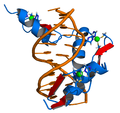Zinc finger
Zinc finger is a small protein structure that is characterized by the coordination of one or more zinc ions in order to stabilize the fold. Originally coined to describe the finger-like appearance of a hypothesized structure from X-ray diffraction, the term now refers to a wide variety of differing protein structures.
Structure[edit]
Zinc fingers form parts of some transcription factors, which are proteins that recognize DNA sequences. They do this by creating a binding site where the zinc ion and the amino acids from the zinc finger protein interact with the DNA molecule. This interaction allows the transcription factor to bind to the DNA sequence and regulate the transcription of DNA to mRNA.
Types[edit]
There are many types of zinc fingers. The classical zinc finger, also known as the Cys2His2 (C2H2) zinc finger, is the most commonly found type in the human genome. Other types include the Cys4, Cys6, and Cys2HisCys zinc fingers. Each type has a unique structure and function.
Function[edit]
Zinc fingers play crucial roles in various biological processes. They are involved in gene regulation, DNA repair, lipid binding, and protein folding. They can also act as enzymes, performing reactions that involve the transfer of functional groups to other molecules.
Clinical significance[edit]
Mutations in zinc finger proteins have been associated with a number of diseases, including some types of cancer, autoimmune diseases, and neurodegenerative diseases. Understanding the structure and function of zinc fingers can therefore provide important insights into the mechanisms of these diseases.
See also[edit]
Ad. Transform your life with W8MD's Budget GLP-1 injections from $75


W8MD offers a medical weight loss program to lose weight in Philadelphia. Our physician-supervised medical weight loss provides:
- Weight loss injections in NYC (generic and brand names):
- Zepbound / Mounjaro, Wegovy / Ozempic, Saxenda
- Most insurances accepted or discounted self-pay rates. We will obtain insurance prior authorizations if needed.
- Generic GLP1 weight loss injections from $75 for the starting dose.
- Also offer prescription weight loss medications including Phentermine, Qsymia, Diethylpropion, Contrave etc.
NYC weight loss doctor appointmentsNYC weight loss doctor appointments
Start your NYC weight loss journey today at our NYC medical weight loss and Philadelphia medical weight loss clinics.
- Call 718-946-5500 to lose weight in NYC or for medical weight loss in Philadelphia 215-676-2334.
- Tags:NYC medical weight loss, Philadelphia lose weight Zepbound NYC, Budget GLP1 weight loss injections, Wegovy Philadelphia, Wegovy NYC, Philadelphia medical weight loss, Brookly weight loss and Wegovy NYC
|
WikiMD's Wellness Encyclopedia |
| Let Food Be Thy Medicine Medicine Thy Food - Hippocrates |
Medical Disclaimer: WikiMD is not a substitute for professional medical advice. The information on WikiMD is provided as an information resource only, may be incorrect, outdated or misleading, and is not to be used or relied on for any diagnostic or treatment purposes. Please consult your health care provider before making any healthcare decisions or for guidance about a specific medical condition. WikiMD expressly disclaims responsibility, and shall have no liability, for any damages, loss, injury, or liability whatsoever suffered as a result of your reliance on the information contained in this site. By visiting this site you agree to the foregoing terms and conditions, which may from time to time be changed or supplemented by WikiMD. If you do not agree to the foregoing terms and conditions, you should not enter or use this site. See full disclaimer.
Credits:Most images are courtesy of Wikimedia commons, and templates, categories Wikipedia, licensed under CC BY SA or similar.
Translate this page: - East Asian
中文,
日本,
한국어,
South Asian
हिन्दी,
தமிழ்,
తెలుగు,
Urdu,
ಕನ್ನಡ,
Southeast Asian
Indonesian,
Vietnamese,
Thai,
မြန်မာဘာသာ,
বাংলা
European
español,
Deutsch,
français,
Greek,
português do Brasil,
polski,
română,
русский,
Nederlands,
norsk,
svenska,
suomi,
Italian
Middle Eastern & African
عربى,
Turkish,
Persian,
Hebrew,
Afrikaans,
isiZulu,
Kiswahili,
Other
Bulgarian,
Hungarian,
Czech,
Swedish,
മലയാളം,
मराठी,
ਪੰਜਾਬੀ,
ગુજરાતી,
Portuguese,
Ukrainian









